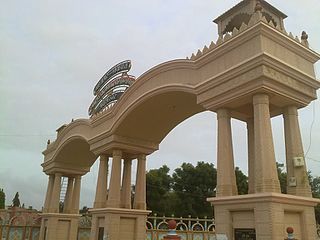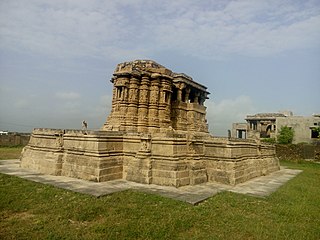
Kutch district, officially spelled Kachchh, is a district of Gujarat state in western India, with its headquarters (capital) at Bhuj. Covering an area of 45,674 km2, it is the largest district of India. The area of Kutch District is larger than the entire area of states like Haryana (44,212 km2) and Kerala (38,863 km2). The population of Kutch is about 2,092,371. It has 10 talukas, 939 villages and 6 municipalities. The Kutch district is home to the Kutchi people who speak the Kutchi language.

Bhuj is a Municipality and District Headquarters of Kutch District in the state of Gujarat, India.

Palanpur is a city and a municipality of Banaskantha district in the Indian state of Gujarat. Palanpur is the administrative headquarters of Banaskantha district. Palanpur is the ancestral home to an industry of Indian diamond merchants.

Madhapar is a village located in Kachchh district in the state of Gujarat, India. It is one of the richest villages in India in terms of bank deposits. The village has around 7600 households and 2000 crore Indian rupee worth bank deposits.

Khedbrahma is a town and a taluka headquarter in Khedbrahma Taluka of Sabarkantha district, Gujarat, India. It is situated on the banks of Harnav river. The town is connected with mythological history and has been pilgrim site for centuries. The 11th century Brahma, Ambika and Pankhnath Mahadev temples are the oldest monuments of the town. The town has an old stepwell, the Brahma Vav. It was under Parmaras, Chaulukyas and Pariharas before it came under Idar State in 13th century.
Nagor or Nagher is a village in Bhuj Taluka of Kutch at a distance of about 8 km from Bhuj town, the capital of Kachchh District of Gujarat in India.
Jagadu (IAST:Jagaḍu), also called Jagadu Shah,Jagdusha or Jagadeva, was a thirteenth century Jain merchant from Bhadreshwar, Kutch (Kachchh).

Kera is a village in Bhuj Taluka of Kutch district of Gujarat, India.this historical town was ruled by the jadeja's before independence in 1947. This historical town has several places of interest; the most important part of the town's history the Darbar gadh, the ruins of an old fort and Shiva temple, and the shrine of a Muslim saint Ghulam Ali.

There is a group of temples of Jainism on Mount Girnar near Junagadh in Junagadh district, Gujarat, India. These temples are sacred to both Digambara and the Svetambara branches of Jainism.

Jasmalnathji Mahadev Temple is a Hindu temple located at Asoda village in Vijapur Taluka, Mehsana district, Gujarat, India. It is locally known as Vaijnath Mahadev temple. The temple is dedicated to Shiva. The temple is built in the 12th century. It consists of a sanctum; mandapa and torana, a porch.
Chamundaraja was an Indian king who ruled parts of present-day Gujarat from his capital at Anahilapataka. He was a member of the Chaulukya dynasty.
Durlabha-raja was an Indian king who ruled parts of present-day Gujarat from his capital at Anahilapataka. He was a member of the Chaulukya dynasty.

Zinzuwada, also spelled Jhinjhuvada or Jhinjhuwada is a town in Dasada Taluka of Surendranagar district, Gujarat, India.

The Khed-Roda Group of Monuments include eighth-ninth century dated seven Hindu temples built during Gurjara-Pratihara or Rashtrakuta period. It also include a reservoir (Kund) and a stepwell. They are located between Raisingpura (Roda) and Khed Chandarani villages, 18 km from Himmatnagar in Sabarkantha district of Gujarat, India. It is located on the bank of the seasonal stream which merges Hathmati river downstream.

The Shiva temple is located at Bavka in Dahod district, Gujarat, India. It is located on a knoll near Hirlav lake between Bavka and Chandavada village, 14 km from Dahod.

The Rama Lakshamana Temples or Samba Lakshamana Temples are the late 12th century twin Hindu temples in Baradia, a village in Okhamandal region of Devbhoomi Dwarka district, Gujarat, India. Baradia is about five km southeast of Dwarka. There are some temples near the coast within the limits of the village.

The Galteshwar is a Hindu temple dedicated to Shiva, located at Sarnal village near Dakor in Kheda district, Gujarat, India. The 12th century temple is unique in its style and of its period because it is built in central Indian Malwa style, bhumija, without influence of Paramara architecture and with influence of Gujarati Chaulukya architecture. It has a square garbhagriha as well as octagonal mandapa.
The Architecture of Gujarat consists of architecture in the Indian state of Gujarat.

Brahma Temple or Brahmaji Mandir is a Hindu temple dedicated to Brahma in Khedbrahma, Gujarat, India. It is built in third quarter of the 11th century.

Ranakdevi's Temple is a 9th or 10th century Hindu temple dedicated to Ranakdevi located in Wadhwan in Surendranagar district of Gujarat, India. It is built in post-Maitraka and early Nagara phase of Māru-Gurjara architecture style.

















